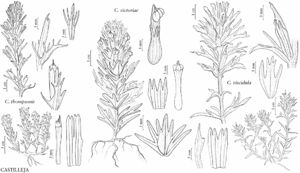Castilleja thompsonii
Proc. Acad. Nat. Sci. Philadelphia 99: 178. 1947.
Herbs, perennial, 0.8–4 dm; from a woody caudex; with a taproot. Stems few-to-many, erect or ascending, unbranched or branched, hairs spreading, long, stiff, sometimes soft (especially in higher elevations), eglandular, mixed with shorter stipitate-glandular ones. Leaves green to purple or reddish-brown, linear to narrowly oblong or linear-lanceolate, 1.4–7.4 cm, not fleshy, margins plane to ± wavy, involute or flat, 3 (–7) -lobed, apex acuminate; lobes spreading-ascending, linear, short to long moving up leaf axis, apex acute or obtuse. Inflorescences 2.5–14 × 1–4 cm; bracts greenish to pale-yellow or reddish-brown throughout, or proximally greenish to dull reddish purple, or ruddy brown, distally greenish to yellow-green or yellow, often aging dull reddish to dull purplish, lanceolate to oblong to ovate, 3–5 (–9) -lobed; lobes spreading to ascending, linear to narrowly lanceolate, long, proximal lobes arising below mid length, apex acute to obtuse. Calyces colored as bracts, 12–25 mm; abaxial and adaxial clefts 4–8 mm, 20–60% of calyx length, deeper than laterals, lateral (0–) 1–3 mm, 7–25% of calyx length; lobes linear, lanceolate, or triangular, apex acute, sometimes obtuse. Corollas straight, 18–21 mm; tube 11–16 mm; subequal to calyx, sometimes beak exserted; beak adaxially green, 5–7 (–8) mm; abaxial lip white, often proximally reddish, prominent, scarcely expanded, ± cylindric, 2.5–4 (–5) mm, 50–70% as long as beak, glabrous or obscurely puberulent; teeth incurved to erect, white, 2.5 mm. 2n = 24, 48.
Phenology: Flowering Apr–Aug(–Sep).
Habitat: Dry slopes, ridges, scabland lithosol soils, meadows, sagebrush steppes, valleys, montane to alpine.
Elevation: 200–2100 m.
Distribution
B.C., Oreg., Wash.
Discussion
Castilleja thompsonii is a characteristic species of the sagebrush communities on the eastern slope of the Cascade Range in Washington, and in the high deserts of the Columbia Basin. Historically, its range approached but apparently never entered Idaho in the Spokane River valley, but much of its habitat in that area is now converted to agriculture or suburban development or overwhelmed by non-native, invasive plants. Castilleja thompsonii occurs in a few sites in the Okanogan Valley region of southern British Columbia and at one site on the eastern slopes of the Cascade Range in Wasco County, Oregon. A distinctive form from the subalpine and alpine zones of Mt. Adams, in the southern Cascade Range of Washington, was named C. villicaulis. This form may merit varietal status under C. thompsonii. While both names were described in the same paper, C. thompsonii is the name used in all regional floras since their publication, after C. villicaulis was reduced to synonymy by M. Ownbey (1959).
Selected References
None.
